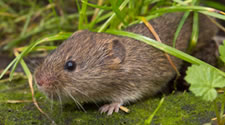To the untrained eye, the appearance of mounds and burrows in your landscape may be mistaken for gophers however they may be the result of moles or voles, unique animals who can create havoc in your yard. Our Gopher Man technicians are experts at controlling and eliminating these animals and are ready to help rid your landscape of them.
Moles

Mole Biology & Behavior
Moles have cylindrical bodies with slender, pointed snouts, and short, bare, or sparsely haired tails. Their limbs are short and spadelike. Their eyes are poorly developed and their ears are not visible. The fur is short, dense, and velvety. Moles have one litter of three or four young during early spring.
Moles create shallow tunnels just below the surface where they capture worms, insects, and other invertebrates. The mounds are formed when moles push soil up to the surface from the underground runways. The excavated soil may be in small chunks, and single mounds often appear in a line over the runway connecting them.They can eat some roots, bulbs, and other plant material, but generally the greatest problem caused by moles is their burrowing, which dislodges plants and dries out their roots. In lawn areas, the mounds and ridges resulting from their burrowing are unsightly and disfiguring.
Treatment
Several methods of control are available, but no simple method has proven fail-proof, so it may be necessary to use a combination of techniques. Trapping is the most universally applicable and dependable method of mole control. To be effective, the trap must be set to catch the mole underground.
Voles

Voles will gnaw the bark of fruit trees from a few inches aboveground to a few inches below ground. If they gnaw completely around the trunk or roots, the trees flow of nutrients and water will be disrupted; this is called girdling. Girdling damage on trunks and roots can kill trees. Signs of partial trunk or root girdling may include a prolonged time before young trees bear fruit, reduced fruit yield, and abnormal yellowish leaf color.
Vole Biology & Behavior
Voles look a bit like mice or pocket gophers, ranging in size between 3 and 7 inches. They have a compact, heavy body, short legs, short-furred tail, small eyes, and partially hidden ears. The long, coarse fur is blackish brown to grayish brown. When fully grown they can measure 5 to 8 inches long, including the tail. A Vole can become sexually mature within a month of being born. Voles may breed any time of year, but the peak breeding period is spring. Voles are extremely prolific with females maturing in 35 to 40 days and having five to ten litters per year. Litter size ranges from three to six. However, voles seldom live past 12 months of age.
Although voles do spend considerable time aboveground and may occasionally be seen scurrying about, most of their time is spent below ground in their burrow system. They are not good climbers so they rarely try to get into homes. The clearest signs of their presence are the well-traveled, aboveground runways that connect burrow openings; the runways are usually hidden beneath a protective layer of grass or other ground cover. The maze of runways leads to multiple burrow openings that are each about 1-1/2 to 2 inches in diameter. The runways are easily found by pulling back overhanging ground cover. Fresh clippings of green grass and greenish-colored droppings about 3/16 inch long in the runways and near the burrows are further evidence of voles.
Treatment
While commercial repellents are available for protecting plants from voles, their effectiveness is questionable and not practical because they must be applied before damage occurs. Burrow fumigants are not effective on voles because their burrowing system is shallow with numerous openings. Bait that will cause the vole to expire is the quickest and most practical means of control and should only be utilized by licensed professionals such as the technicians at the Gopher Man.
Legal Notice
Voles and moles are classified as nongame mammals by the California Fish and Game code. Nongame mammals which are found to be injuring crops or other property may be controlled at any time or in any manner that is legal and humane by the owner or tenant of the property. They may also be controlled by federal, state or county officers or employees while acting in their official capacities.